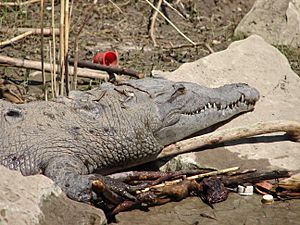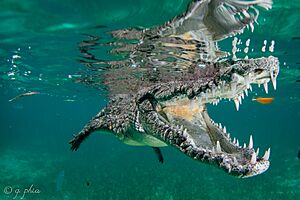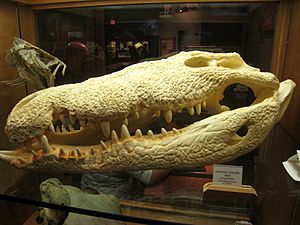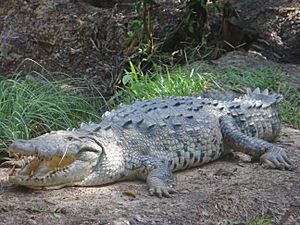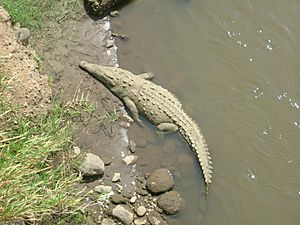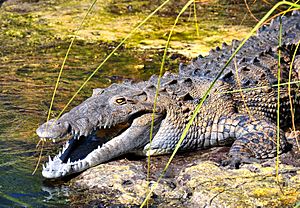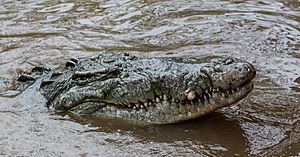American crocodile facts for kids
Quick facts for kids American crocodile |
|
|---|---|
 |
|
| Scientific classification | |
| Kingdom: | |
| Class: | |
| Order: | |
| Family: | |
| Genus: | |
| Binomial name | |
| Crocodylus acutus |
|
The American crocodile (Crocodylus acutus) is a type of crocodile found in warm parts of the Americas. It's the most common of the four crocodile species living in the Americas. You can find them from South Florida and Mexico all the way down to Peru and Venezuela. Its scientific name, Crocodylus acutus, means 'Pointy-snouted crocodile' because of its sharp snout.
American crocodiles mostly live near the coast. They are also found in river systems. However, they prefer salty water. This means they often live in brackish lakes, mangrove swamps, lagoons, cays, and small islands.
Other crocodiles can also handle saltwater. This is thanks to special salt glands under their tongue. But the American crocodile is special. It's one of the few species, like the saltwater crocodile, that commonly lives and thrives in saltwater. They can even be found on beaches and small islands with no freshwater source. This includes many islets across the Bahamas and the Caribbean. They also live in very salty lakes. One of the largest groups lives in Lago Enriquillo.
American crocodiles mainly eat fish. But large ones might hunt bigger animals, like deer. A crocodile can look like a log, hiding just below the water's surface. When a deer comes to drink, the crocodile lunges out. It grabs the deer in its powerful jaws and pulls it underwater. The deer then drowns.
After the deer is dead, the crocodile will grab a piece of meat. It then spins around in a "death roll." American crocodiles can be quite aggressive. They have been known to attack humans. Attacks are rare, but they happen most often in Mexico.

Contents
Name
The American crocodile was first described by a scientist named Georges Cuvier in 1807. He called it the "sharp-snout alligator" at first. Later, in 1822, another scientist, Constantine Samuel Rafinesque, realized it was actually a crocodile.
In 1875, a man named William Temple Hornaday thought he had found a new type of crocodile in Florida. He called it Crocodylus floridanus. However, scientists later realized it was the same species as the American crocodile. So, Crocodylus floridanus is no longer a valid name.
Recent studies of crocodile DNA show that American crocodiles in Jamaica might be a bit different from the Cuban crocodile, even though they have mixed in the past. Other studies suggest that crocodiles on islands like Cozumel might even be their own unique species.
How They Evolved
Scientists used to know little about how the American crocodile evolved. But in 2020, they discovered an ancient crocodile species called Crocodylus checchiai. This discovery suggests that the American crocodile, along with the Orinoco crocodile, Morelet's crocodile, and Cuban crocodile, all share an ancestor from Africa. This ancient animal might be the missing link that explains how crocodiles spread from Africa to the Americas.
The group of crocodiles called Crocodylus likely started in Africa. From there, they spread to places like Southeast Asia and the Americas. Scientists believe that Crocodylus split off from its closest relative, an extinct crocodile from Madagascar called Voay, about 25 million years ago. American crocodiles in Florida, Jamaica, and the Dominican Republic have slight differences in their genes. The oldest confirmed fossil of an American crocodile was found in El Salvador.
What Makes American Crocodiles Unique?
Like all crocodiles, the American crocodile has four short, strong legs. It has a long, powerful tail. Its skin is scaly with rows of bony plates called scutes. These run down its back and tail. Its snout is long and narrow. It has very strong jaws. Its eyes have special clear eyelids for protection. These are called nictitating membranes. It also has glands that make tears.
Its nostrils, eyes, and ears are on top of its head. This lets the rest of its body stay hidden underwater. This helps them surprise their prey. Camouflage also helps them hunt. The American crocodile's snout is longer and narrower than that of the American alligator.
American crocodiles are also paler and more grayish than the darker American alligator. This crocodile usually crawls on its belly. But it can also "high walk," lifting its body off the ground. Big crocodiles can charge up to nearly 10 mph (16 km/h). They can swim as fast as 20 mph (32 km/h). They do this by twisting their bodies and tails. However, they can't keep up this speed for long.
Alligators can survive when their body temperature drops to 38 degrees Fahrenheit. But American crocodiles are better at handling saltwater than alligators. American crocodiles have been seen 140 mi (230 km) away from shore in the Caribbean Sea.
How Big Do They Get?
New baby crocodiles are about 27 cm (10.6 in) long. They weigh about 60 g (2.1 oz). An average adult male in rivers can be 2.9 to 4 m (9 ft 6 in to 13 ft 1 in) long. They can weigh up to 382 kg (842 lb). Females are usually 2.5 to 3 m (8 ft 2 in to 9 ft 10 in) long. They weigh up to 173 kg (381 lb).
Two scientists filming for the show MonsterQuest saw a very large American crocodile. They thought it was 5 to 5.5 m (16 ft 5 in to 18 ft 1 in) long. They saw it deep inside Everglades National Park in Florida.
Where Do American Crocodiles Live?
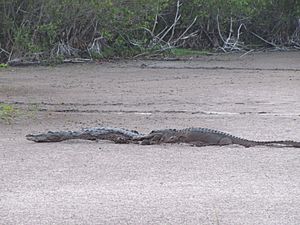
The American crocodile's home in southern Florida is also where the American alligator lives. However, alligators live as far north as Virginia. American crocodiles in the United States only live in southern Florida. This is because alligators can handle cold weather much better than crocodiles.
American crocodiles in the United States live with the American alligator. They are mainly found south of Miami. This includes Everglades National Park, Florida Bay, Biscayne Bay, and the Florida Keys.
A good number of them live near Homestead, Florida, at the Turkey Point Nuclear Generating Station. Some crocodiles travel north to warmer summer waters. They have been seen in Sarasota County and Palm Beach County. In 2008, a crocodile was caught in the ocean at Isle of Palms, South Carolina. In 2013, a crocodile weighing about 700 pounds was caught in Tarpon Springs, Florida. However, American crocodiles of similar lengths have been accurately weighed at 450–500 lbs.
What Do American Crocodiles Eat?
The American crocodile's snout is wider than some other fish-eating crocodiles. This allows it to eat many different kinds of prey. Also, its snout gets even wider and stronger as it grows older.
Their prey can be as small as insects for young crocodiles. It can be as large as full-grown cattle for big adults. They eat many birds, mammals, turtles, crabs, snails, and frogs. Sometimes, they also eat carrion (dead animals).
In Haiti, baby and young American crocodiles mostly ate fiddler crabs. These crabs made up a large part of their diet. For very young crocodiles, aquatic insects, their larvae, and snails are also important foods. Growing American crocodiles have a more varied diet. This can include insects, fish, frogs, small turtles, birds, and small mammals.
In Florida, adult American crocodiles mainly eat bass, tarpon, and especially mullet. They also eat large crabs, snakes, and mammals. These mammals live near the rivers and coastal areas of the Everglades. Examples include opossums and raccoons.
In Haiti, adult crocodiles seemed to eat mostly various birds. These included herons, storks, flamingos, pelicans, grebes, coots, and moorhens. They also ate marine fish like Tilapia. Sometimes, they were seen catching turtles, dogs, and goats.
Adult American crocodiles have no natural predators. Almost any animal they meet on land or near water is a possible meal. American crocodiles are known to hunt lemon sharks. Sharks often avoid areas where American crocodiles live.
How Do They Reproduce?
American crocodiles breed in late fall or early winter. Males make very deep calls to attract females. In February or March, females start building nests. These nests are made of sand, mud, and dead plants near the water. The nest's location is very important. With the right amount of plants, the eggs will develop at a good temperature.
The sex of baby crocodiles depends on the temperature of the nest. Small changes in temperature can lead to all-male or all-female babies. This could harm the population. About a month later, the female digs a wide hole in the nest. She lays 30 to 70 eggs, depending on her size. After laying, she might cover the eggs with debris or leave them open. The white, long eggs are 8 cm (3.1 in) long and 5 cm (2.0 in) wide. They have many tiny holes in their shell.
Crocodile eggs are somewhat fragile, but softer than bird eggs. The young hatch after 75–80 days. During this time, the parents guard the nest. They often stay in a hole nearby. Females are especially known to protect their nests fiercely. But even with this protection, American crocodile eggs can be eaten. Predators include raccoons, coatis, foxes, skunks, and other scavenging mammals. Large predatory ants, crabs, and vultures also eat them.
Baby crocodiles are 24 to 27 cm (9.4 to 10.6 in) long. They start hunting for food within a few days of hatching. It's common for the mother to care for her young for weeks after they hatch. She listens to their calls and continues to carry them. About five weeks after hatching, the young American crocodiles leave to live on their own.
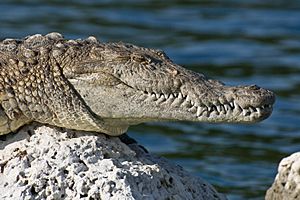
This species mostly lives in tropical areas with clear rainy seasons. The young hatch around the time of the first summer rains (July–August). This is after the dry season and before the water bodies flood. When the young crocodiles are hatching, they are most in danger. They instinctively make soft, grunting sounds. These sounds tell the female to come to the nest. She uncovers the eggs if they were covered. Then she helps the babies break out of their eggs. She scoops them up with her mouth and carries them to the nearest water.
Are American Crocodiles Endangered?

Yes, in some areas, the American crocodile is an endangered animal. This is due to hunting for their hides, pollution, losing their homes, and adults being taken for farms. In 1972, Venezuela stopped crocodile skin hunting for ten years. This was because too many were hunted in the 1950s and 1960s.
About 1,000 to 2,000 American crocodiles live in Mexico, Central, and South America. But we don't have enough information about their exact numbers. The American crocodile is considered a vulnerable species. However, its status hasn't been checked since 1996.
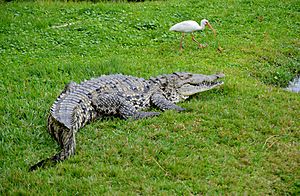
There are an estimated 500 to 1,200 wild American crocodiles in southern Florida. On March 20, 2007, the United States Fish and Wildlife Service changed the American crocodile's status. It was no longer "endangered" but became "threatened." This means it's still protected. It's illegal to bother, poach, or kill them under the federal Endangered Species Act. In southern Florida, 67.8% of American crocodile deaths were likely caused by road accidents.
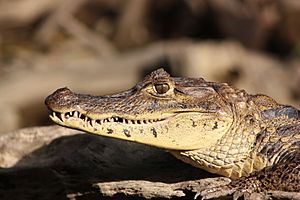
How Do They Interact with Humans?
It's important to remember that American crocodiles are wild animals. While they are generally shy and tend to avoid people, it's always best to keep a safe distance. They are considered moderately aggressive compared to other crocodiles around the world. However, they have had more interactions with people than some other American crocodiles. Serious incidents are not common, especially compared to the very aggressive Saltwater crocodile and Nile crocodile.
American crocodiles are known for being shy. They usually try to get away from humans as soon as they see them. The Cuban crocodile is smaller but more aggressive than the American crocodile. It can sometimes scare away American crocodiles in shared enclosures. However, because Cuban crocodiles live in a much smaller area, interactions with humans are rarely reported.
Images for kids
-
An American crocodile in Everglades National Park. Although considered only moderately aggressive by the standards of crocodilians worldwide, the American crocodile is likely the most dangerous American crocodilian and attacks are frequently fatal due to the size and formidable teeth of the species.
See also
 In Spanish: Cocodrilo americano para niños
In Spanish: Cocodrilo americano para niños


